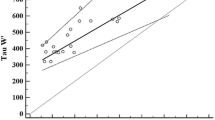Abstract
Commonly, muscle phosphocreatine (PCr) recovery from exercise has been fitted to a monoexponential function. However, a number of experiments indicate that at low muscle pH, a monoexponential fit is not suitable. We have performed in vivo 31P-MRS measurements of PCr during recovery from high-intensity intermittent exercise where muscle pH dropped below 6.5 (35 out of 40 cases). Results of a statistical analysis showed that monoexponentiality should be rejected in 32 out of 40 cases. Therefore, a Monte Carlo simulation was carried out to test the quality of competing models used in the literature at low pH: monoexponential, biexponential and changing rate utilization resource (CRUR). For each model, random Gaussian-distributed errors were imposed on simulated PCr recovery before performing the fits. A monoexponential function (three estimated parameters) provided a correct estimation of parameters (unbiased, normally distributed, poorly correlated estimates) and, therefore, should be preferred. When alternative functions are required, as in 32 cases out of 40 in the present study, it is demonstrated that a biexponential function (five estimated parameters) is not well suited (estimates were correlated), whereas a CRUR function (four estimated parameters) provides correct estimation of the parameters. It is concluded that a biexponential fit to PCr recovery is too sensitive to experimental errors to be practicable. Statistical and physiological relevance of CRUR are discussed.





Similar content being viewed by others
References
Bagdonavicius V, Nikulin M (1998) Additive and multiplicative semi-parametric models in accelerated life testing and survival analysis. Queen’s paper in pure and applied mathematics, vol. 108. Queen’s University, Kingston, Ontario
Bates JH (1993) Stochastic model of the pulmonary airway tree and its implications for bronchial responsiveness. J Appl Physiol 75:2493–2499
Bogdanis GC, Nevill ME, Boobis LH, Lakomy HK, Nevill AM (1995) Recovery of power output and muscle metabolites following 30 s of maximal sprint cycling in man. J Physiol 482:467–480
Brand MD (1997) Regulation analysis of energy metabolism. J Exp Biol 200:193–202
Conley KE, Jubrias SA, Esselman PC (2000) Oxidative capacity and ageing in human muscle. J Physiol (Lond) 526:203–210
Eidelman DH, Ghezzo H, Bates JH (1990) Exponential fitting of pressure-volume curves: confidence limits and sensitivity to noise. J Appl Physiol 69:1538–1541
Harkema SJ, Meyer RA (1997) Effect of acidosis on control of respiration in skeletal muscle. Am J Physiol 272:C491–500
Harris RC, Edwards RH, Hultman E, Nordesjo LO, Nylind B, Sahlin K (1976) The time course of phosphorylcreatine resynthesis during recovery of the quadriceps muscle in man. Pflugers Arch 367:137–142
Haseler LJ, Hogan MC, Richardson RS (1999) Skeletal muscle phosphocreatine recovery in exercise-trained humans is dependent on O2 availability. J Appl Physiol 86:2013–2018
Mahler M (1985) First-order kinetics of muscle oxygen consumption, and an equivalent proportionality between QO2 and phosphorylcreatine level. Implications for the control of respiration. J Gen Physiol 86:135
McCann DJ, Mole PA, Caton JR (1995) Phosphocreatine kinetics in humans during exercise and recovery. Med Sci Sports Exerc 27:378–389
McCully KK, Iotti S, Kendrick K, Wang Z, Posner JD, Leigh J Jr, Chance B (1994) Simultaneous in vivo measurements of HbO2 saturation and PCr kinetics after exercise in normal humans. J Appl Physiol 77:5–10
Meyer RA (1988) A linear model of muscle respiration explains monoexponential phosphocreatine changes. Am J Physiol 254:C548–553
Nevill AM, Jones DA, McIntyre D, Bogdanis GC, Nevill ME (1997) A model for phosphocreatine resynthesis. J Appl Physiol 82:329–335
Paganini AT, Foley JM, Meyer RA (1997) Linear dependence of muscle phosphocreatine kinetics on oxidative capacity. Am J Physiol 272:C501–510
Prampero PE di (1984) The control of muscle oxygen consumption after heavy exercise. Boll Soc Ital Biol Sper 40 [Suppl] 3:80–81
Roussel M, Mattei JP, Le Fur Y, Ghattas B, Cozzone PJ, Bendahan D (2003) Metabolic determinants of the onset of acidosis in exercising human muscle: a 31P-MRS study. J Appl Physiol 94:1145–1152
Simon BA, Marcucci C, Fung M, Lele SR (1998) Parameter estimation and confidence intervals for Xe-CT ventilation studies: a Monte Carlo approach. J Appl Physiol 84:709–716
Solev V, Gerville-Réache L (2000) Estimation of a function observed with a stationary error. J Math Sci 99:1182–1190
Taylor DJ, Bore PJ, Styles P, Gadian DG, Radda GK(1983) Bioenergetics of intact human muscle. A 31P-nuclear magnetic resonance study. Mol Biol Med 1:77–94
Thompson CH, Kemp GJ, Sanderson AL, Radda GK (1995) Skeletal muscle mitochondrial function studied by kinetic analysis of postexercise phosphocreatine resynthesis. J Appl Physiol 78:2131–2139
Walter G, Vandenborne K, McCully KK, Leigh JS (1997) Noninvasive measurement of phosphocreatine recovery kinetics in single human muscles. Am J Physiol 272:C525–534
Author information
Authors and Affiliations
Corresponding author
Rights and permissions
About this article
Cite this article
Arsac, L.M., Thiaudière, E., Diolez, P. et al. Parameter estimation in modeling phosphocreatine recovery in human skeletal muscle. Eur J Appl Physiol 91, 419–424 (2004). https://doi.org/10.1007/s00421-003-1001-5
Accepted:
Published:
Issue Date:
DOI: https://doi.org/10.1007/s00421-003-1001-5




